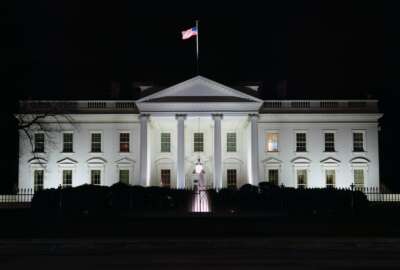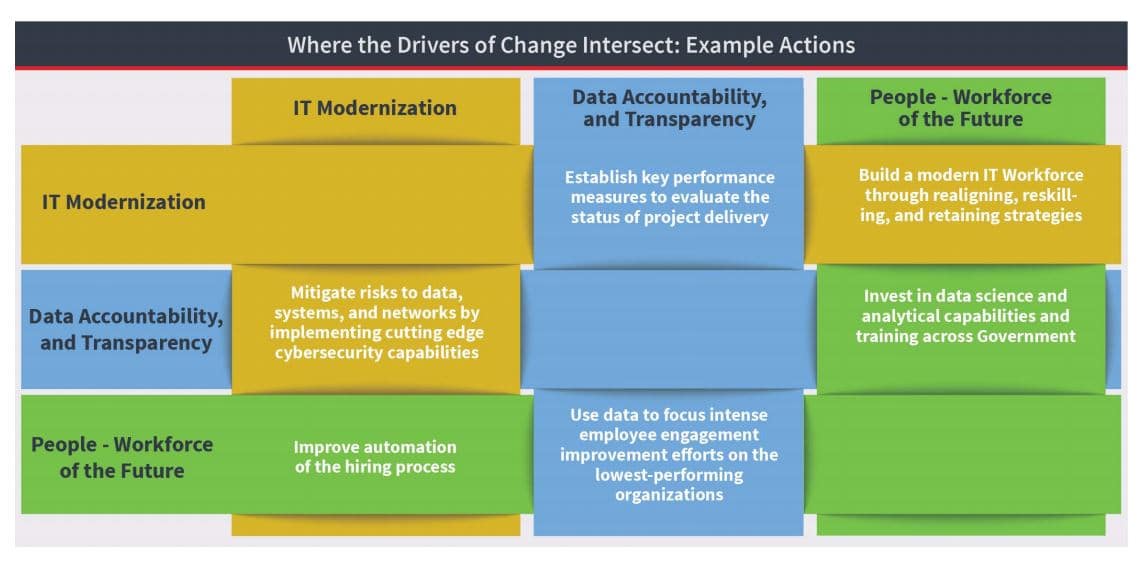
OMB details 14 cross-agency priority goals in unveiling new President’s Management Agenda
The President's Management Agenda describes 14 cross-agency priority goals that the Trump administration will focus on in the coming years.
Best listening experience is on Chrome, Firefox or Safari. Subscribe to Federal Drive’s daily audio interviews on Apple Podcasts or PodcastOne.
The Trump administration isn’t trying to reinvent the wheel with its new President’s Management Agenda, which the Office of Management and Budget officially launched Tuesday morning.
But it is attempting to get the ball moving on conversations about IT modernization, data transparency and the workforce that the federal community has been having for years but hasn’t been able to fully tackle.
“When we were tasked with creating the president’s management agenda, both OMB and [the Office of Personnel Management] got together and said, ‘What do we want to do? What do we want to do on our watch? What have we been waiting for in the last 20-to-30 years, maybe even 40 years, in terms of updating our personnel systems?'” OPM Director Jeff Pon said Tuesday morning at the administration’s official launch event in Kansas City, Missouri.
The president included the basics of his new management agenda in his fiscal 2019 budget proposal, but Tuesday’s release announces more details, including the addition of 14 cross-agency priority goals.
“Rather than throwing money at the problem or pursuing short-term fixes that become outdated as soon as we implement them, this administration is investing in a deep-seated transformation through the President’s Management Agenda,” Margaret Weichert, OMB’s new deputy director for management, said. “This agenda lays out a long term vision for modernizing the federal government in key areas that will improve the ability of agencies to work on behalf of the people to deliver mission outcomes, provide excellent service to the American people and effectively steward taxpayer dollars.”
The agenda describes three broad “drivers of transformation,” which are, on their own, cross agency priority goals:
- IT modernization.
- Data, accountability and transparency.
- Workforce for the 21st century.
Many of the themes included in the president’s new management agenda will be familiar ones, but Weichert said it’s by design.
“You’ve heard administrations in the past talk about many of these same topics,” she said. “We’re not inventing something wholly new, but what we are doing is focusing on getting ‘her’ done.”
With its newly sworn-in director, OPM has an ambitious plan to reimagine the federal workforce and civil service personnel systems.
The PMA report described a current performance management system that “fails to reward the best and address the worst employees.”
“We’re going to demonstrate some new ways in looking at the workforce, not only in recruitment or performance management, or even separation management … but the DNA of how we actually reward people, how our culture works,” Pon said. “The whole philosophy of having a job for life is a thing of the past.”
But in perhaps its most pointed and direct terms yet, the administration described its plans to realign the federal workforce and redesign the current pay, pension and bonus structure. The PMA report doesn’t suggest any new changes to federal pay and benefits beyond what President Donald Trump included in his 2019 budget request.
“The administration intends to partner with Congress on overhauling the statutory and regulatory rules that have, over time, created an incomprehensible and unmanageable civil service system,” the report said.
Creating a 21st century workforce will mean possible changes to federal hiring, training and reskilling opportunities, Pon said.
The General Services Administration, as it’s previously described, will take the lead on IT modernization, advancing shared services and standing up new Centers of Excellence to help agencies accelerate and leverage private sector best practices.
The agency last week awarded five contracts for phase one of its Centers of Excellence initiative to modernize technology at USDA.
“Implementing this best practice in the private sector will help us move from, for example, five payroll systems to a single shared provider,” GSA Administrator Emily Murphy said. “This process will help government eliminate costly duplication and save valuable taxpayer money.”
Beyond the three main priority goals, the administration named 11 others for a total of 14:
- Improving customer experience with federal services;
- Sharing quality services;
- Shifting from low-value to high-value work;
- Category management: leveraging common contracts and best practices to drive savings and efficiencies;
- Results-oriented accountability for grants;
- Getting payments right;
- Improving outcomes through federal IT spending transparency;
- Improving management of major acquisitions;
- Modernize infrastructure permitting;
- Security clearance, suitability and credentialing reform; and
- Improving transfer of federally-funded technologies from lab to market.
Many of the 14 cross-agency priority goals also remain the same or similar from the previous administration.
Security clearance, suitability and credentialing reform, for example, remains a CAP goal. Leadership on the Performance Accountability Council (PAC), which agency officials and industry experts recently said was lacking and desperately needed, will continue to oversee this effort.
Other goals represent a new direction for the administration, such as OMB’s goal to modernize infrastructure permitting. The Federal Permitting Improvement Steering Council will focus on reducing the time it takes to review and authorize major infrastructure projects.
In addition, the Trump administration’s vision describes — perhaps more so than other management agendas — how all of these priorities intersect and inform one another.
For example, the administration’s data transparency efforts will help inform OMB focus more intently on low-performing agencies with low employee morale, while GSA’s IT modernization work will aid OPM’s efforts to automate and improve the hiring process.

The administration wanted to launch the management agenda outside of the nation’s capital, noting that 80 percent of the federal workforce lives outside of the Washington, D.C. area. Kansas City, Missouri, alone has 50,000 federal employees, Weichert said.
After the PMA launch, administration officials have visits planned at the Agriculture, Health and Human Services, Veterans Affairs Departments, along with OPM, GSA and IRS facilities in the region.
The Partnership for Public Service praised the president’s new agenda.
“The president’s management agenda will be critical to the success of his administration given the mounting and complex challenges facing our government, the speed with which change is taking place and the need to govern effectively,” President and CEO Max Stier said in a statement. “I applaud the president for prioritizing the federal workforce, IT modernization, and data and transparency as the three drivers to transform how our government operates.”
The Senior Executives Association also applauded the PMA and said it looks forward to working with the Trump administration on developing ideas to move the agenda forward.
“The PMA rightly identifies many of the impediments our federal government confronts on a daily basis, while also correctly recognizing that the necessary solutions will require long-term commitment,” SEA President Bill Valdez said.
Copyright © 2025 Federal News Network. All rights reserved. This website is not intended for users located within the European Economic Area.
Nicole Ogrysko is a reporter for Federal News Network focusing on the federal workforce and federal pay and benefits.
Follow @nogryskoWFED





